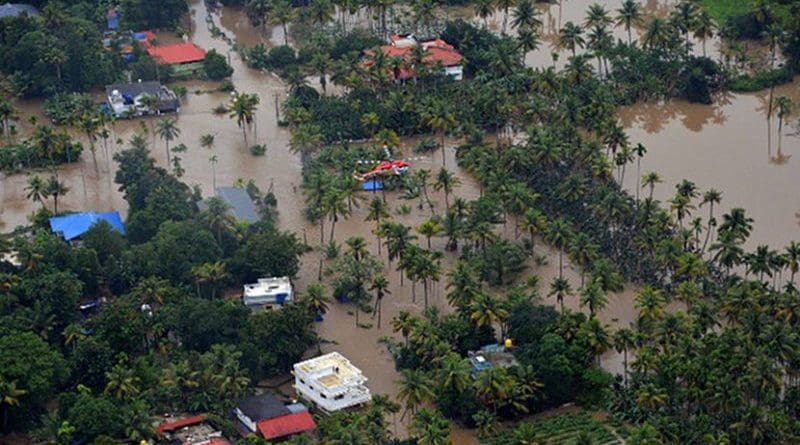Religion In Disaster Reporting: Lessons From Kerala – OpEd
The 2018 flood in the Indian state of Kerala was an eye opener for many reasons. By the time the rains stopped and flood waters began receding it had brought to the fore the Achilles Heel of India’s development model. It also gave rise to the observation that there is a place and time for everything, and discussions during this disaster on the reasons for the suggestions of the Western Ghats Ecology Expert Panel (WGEEP), also known as Gadgil Commission Report, not being implemented was not really opportune. Hate mongers rose to new levels suggesting the floods were divine retribution against the Marxists, Liberals, Christians, Muslims, Beef Eaters and those wishing to change traditions. Was this the reason for the Bharatiya Janata Party (BJP) government’s, at the center and state, unwillingness to provide aid? That Hindus were collateral damage in this divine vengeance was ignored, proving that some are ignorant of their god’s secularism. The insinuation of divine retribution transmogrified into the suggestion that Hindus only help Hindus. The shift indicating the necessity for some Hindus to become the lighting rods for their secular and therefore ineffective gods.
The colour of aid
At the same time there was an outpouring of aid of every kind for the flood affected people of Kerala. People also shamed those promulgating such loathe filled views. Unfortunately, in some instances the acceptance of aid was coloured by caste and religion. There were cases of upper caste Christian survivors unwilling to share space and food with their lower caste brethren. Fishermen who put their lives and livelihood on the line to save lives had to deal with Hindus refusing to be rescued by them.
Indian media recorded these moments of man-made divides and of humans at their best. Social media played the devils advocate. Many used it to create platforms to help the flood survivors, others harnessed the floods devastation and the ensuing human and environmental tragedy to communicate their vile ideology.
It is important, in these times in India, to call out religious and casteist bigotry. However, the question for Indians and the Indian media is whether human goodness should be recorded and celebrated through the lens of religion. In other words, should humaneness be coloured with the same brush strokes as caste or religious based depravity.
Undoubtedly there are enough instances to prove that many media outlets are part of the Indian government’s right wing chorale. Therefore this dilemma is not something they would wish to mull over. But for the handful who continue to be impartial, should they nuance their reporting to differentiate between the two?
What lies beneath
How different are Sikhs who started a langar (communal free kitchen) to feed the victims of the floods from the Hindus who gave space in their temple for namaz (Muslim prayer) or from the Hindu family protecting a Christian relic or the Muslims cleaning a temple? The only thing that differentiates these people are their religious identities but what binds them is their duty to their fellow being.
By highlighting religious identities in such occasions are we actually surprised that people of a different creed can come to the aid of others? The need to highlight the religion of people coming together to work for common good shows how deep-rooted these ersatz identities are. It almost seems that no one expects others of human decency and kindness even in times of need. Worse still is the underlying assumption that basic humanity no longer exists and is subsumed by the diktats of religion and caste. The air time given to people like Chakrapani (the head of the Hindu Mahasabha, a group claiming to protect and preserve Hindu culture) who said, “help only those who don’t eat beef”, and those of his ilk moulding their hate driven Hindutva ideology to cater to this disaster only substantiates and reinforces this belief.
In highlighting religion one is ignoring the reasons that propel people to help. In fact such kind of reporting undermines the foundation on which communities, societies and nations are built – trust, mutual respect and the belief that each will come to the aid the other in times of need.
Old wine in new bottle?
Undoubtedly, such articles are attempts to show the good in religions and therefore break stereotypes so prevalent in India. It is undeniable that such reporting is a response to the current communal tinder box that the country is being forced to live in. Religion forces people to don costumes. Therefore unsurprisingly, even good intentions become catwalks for these costumes. By locking on to the good side of religion while others build on it’s malevolence and inseminate Indian society with it, the focus still remains on what divides – religion. The underlying humanity of people doing good is diluted, if not ignored, when the media add religion to their reports.
It is important to call out religious bigotry for what it is. However, responding to such sectarianism by dressing religion in another cloak only embeds religion further into the consciousness of Indian society and accentuates the divisions. The challenge before Indian media and Indian’s is to see the best in each other and themselves without the lens of religion.
The right is blighted by the blindness of their religious fixations. To believe that playing another version of the religious card will be effective in dousing it’s flames is wishful thinking. Attempts to furnish another narrative only provides a dais to accentuate and promote distinctions because religion still remains the cornerstone on which the story is built on. Instead of fighting fire with fire, let our humanity be acknowledged. This would take away the legs on which the zealots and their philosophy stand on while presenting us with a reason to celebrate and respect ourselves and not the religions we have made.
Samir Nazareth is the author of 1400 Bananas, 76 Towns & 1 Million People. He tweets at @samirwrites

